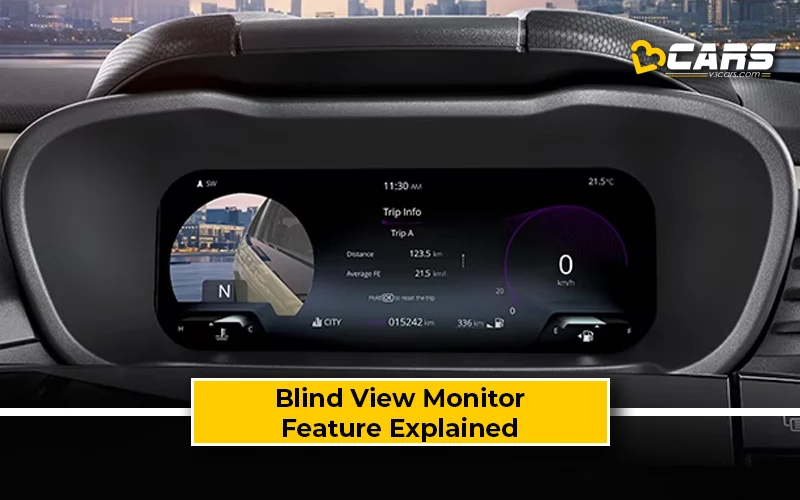Blind View Monitor – Feature Explained
Changing lanes or making turns can be risky due to blind spots – areas around the vehicle that are not visible in the rearview or side mirrors. The Blind View Monitor (BVM) is an advanced safety feature designed to eliminate these blind spots, providing the driver with a clear visual of adjacent lanes and significantly enhancing safety during maneuvers.

What Is A Blind View Monitor?
A Blind View Monitor (BVM) is a driver assistance system that displays a live video feed of the vehicle’s blind spots on the infotainment screen or instrument cluster when the turn signal is activated. This provides the driver with an immediate and clear visual of traffic or obstacles in the adjacent lanes.
How Does A Blind View Monitor Work?
The BVM system integrates cameras and display technology to provide real-time blind spot visibility:
- Side-Mounted Cameras: Small cameras are strategically mounted on the sides of the vehicle, typically under the side mirrors. These cameras are angled to capture the blind spot areas that are not visible in the ORVMs.
- Turn Signal Activation: The system is primarily activated when the driver engages the turn signal (left or right).
- Live Video Feed: Upon turn signal activation, the corresponding side camera (left camera for left turn signal, right camera for right turn signal) transmits a live video feed.
- Display Integration: This live video feed is then displayed prominently on the car’s central infotainment screen or, in some advanced systems, directly within the digital instrument cluster. This allows the driver to quickly glance at the screen for a clear view of the blind spot before initiating a lane change or turn.
- Dynamic Overlays (Optional): Some systems may include dynamic guidance lines or warnings overlaid on the video feed to indicate safe distances or potential collision risks.
- Integration with Blind Spot Monitoring (BSM): BVM often works in conjunction with a Blind Spot Monitoring (BSM) system, which uses radar or ultrasonic sensors to detect vehicles in blind spots and provides visual (warning light in the mirror) and/or audible alerts. BVM adds a direct visual confirmation to these alerts.
Also Read: What Is Blind Spot Mirrors? Feature Explained
What Are The Pros And Cons Of A Blind View Monitor?
Here are the pros, or advantages of a blind view monitor:
- Eliminates Blind Spots: Provides a clear, live visual of areas that are otherwise hidden from the driver’s view, significantly reducing the risk of side collisions during lane changes.
- Enhanced Safety: Improves overall road safety by giving the driver more comprehensive situational awareness before manoeuvring.
- Increased Confidence: Boosts driver confidence, especially when changing lanes on busy highways or in heavy traffic.
- Intuitive Visual Aid: The direct video feed is often more intuitive and easier to interpret than just a warning light or chime.
Here are the cons, or disadvantages, of a blind view monitor:
- Added Cost: This is typically a premium feature found in higher variants, contributing to a higher vehicle price.
- Screen Glance: While helpful, it still requires the driver to glance away from the road ahead to view the screen, which can be a momentary distraction.
- Lens Obscuration: The camera lenses can get dirty, fogged, or blocked by external elements (rain, mud, snow), impairing their functionality.
- Not a Substitute for Head Checks: While highly effective, BVM should complement, not replace, traditional head checks and mirror usage for maximum safety.
Can A Blind View Monitor be installed from the aftermarket?
Installing a full-fledged Blind View Monitor system from the aftermarket is highly complex and generally not recommended for seamless integration. While aftermarket blind spot detection systems (using radar/ultrasonic sensors with warning lights) are available, a true BVM that displays live video on the infotainment screen requires deep integration with the vehicle’s wiring, CAN-bus system, turn signal logic, and display unit. This level of integration is difficult and costly to achieve reliably in the aftermarket and could potentially interfere with other vehicle electronics.
Affordable Cars in India That Offer A Blind View Monitor?
Currently, the 2025 Tata Altroz facelift is the most affordable car in India to offer a blind view monitor. However, it is only available in the top variant of the Tata hatchback. Other cars that offer this feature include the Hyundai Alcazar, Kia Carens, Hyundai Creta and Kia Seltos.
Availability can vary significantly based on the specific model year, variant, and manufacturer’s packaging of features. It’s always advisable to verify the features with the manufacturer or dealership for the most accurate information.
Also Read: Top EVs In India With Over 500km Range
Helpful Tools:
- Fuel Cost Calculator for Cars – Know your monthly fuel expense based on usage and mileage
- Car On-Road Price Calculator – Convert ex-showroom to on-road price for any city
Sell Used Car Online – Enter your car and contact details to get an instant price estimate and book a free inspection with our partner network


can I install it at showroom separately with altroz2025 pure segment?